What the Future of Healthcare Looks Like

Healthcare, like other industries, is shifting and evolving to keep pace with the needs and technologies of the public. This means that competent physicians need to be able to evolve and change the way that they practice medicine to keep up with the latest developments and trends.
Some of the current trends that seem likely to become permanent tools, techniques or practices include whole body treatments, online access to information and doctors, and a surge in medical related tech.
Whole Body Care and Diagnosis
More physicians are embracing treating and diagnosing the whole person instead of the acute symptoms. For instance, weight gain can be caused by physical injuries making it painful to exercise, a change in medications, thyroid issues or a combination of all three. In the past, doctors would advise patients to eat better and exercise more without examining possible complicating issues. Physicians practicing whole body care, however, are more likely to advise their patients to start a program like Thrive Experience and order x-rays and blood panels to address factors such as pain or lower energy levels.
A.I., VR, and Online Medicine
Artificial intelligence mines data from multiple sources and puts together reports for businesses in almost every industry. In health care, this tech can help pull relevant information from patient medical records as well as from diagnostic or treatment databases faster than physicians can to design possible treatment plans. When combined with online medicine, AI can help nervous parents determine whether a visit to the doctor or instant care facility is necessary, advise at-home treatments to try before making an appointment or even design a treatment plan while the physician or nurse is in a video consultation with a patient. Virtual Reality is already being used to train physicians, surgeons and specialists in complex procedures, but it can also help keep the spirits up of those undergoing in-patient treatments. Patients can escape to their favorite museum or play their favorite sport while on bed rest at home or in the hospital.
Patient Centric and Health Care Teams
Shifting your practice to be more patient centric is a trend that has been gaining traction each time new business and medical tech is introduced. The internet and advanced security protocols have made it easier for patients to access records and test results from their home computer, online appointment scheduling gives them the opportunity to make appointments when they remember rather than during business hours, and increased communication abilities allows doctors to send prescriptions directly to the pharmacy so they are filled and waiting when the patient get there. This shift can also be aided by having a team of physicians, nurses and specialists working with patients with the primary care physician acting as the patient care organizer. Using the team approach can shift medical care from treatment to prevention for more rewards in the physical and financial health of the patient.
AR and Wearable Tech
Augmented Reality can aid doctors in both diagnostics and improving patient morale. For instance, with AR, a physician can see test results displayed next to a patient in a video chat or medical students can study accurate anatomy on their smartphone. When combined with wearable tech, like heart rate monitors or workout trackers, AR can help doctors and patients visualize the information and build a virtual model for the patient. Those with wearable tech like fitness trackers can already use AR to turn workouts into videogames and send their health stats to doctors, insurance companies and physical trainers.
The future of healthcare is looking bright with a focus on more patient centric, whole body care using the latest in tracking, data mining and diagnostic technology. Medical care teams are also becoming more popular with primary care physicians because it allows them to see more patients and develop better treatment plans with the help of talented nurses, care specialists and therapists. Combining the latest technology with emerging care techniques can change the healthcare industry in ways that optimize prevention without compromising treatment.